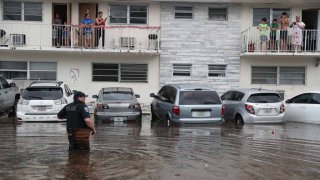
HOLLYWOOD, FLORIDA – DECEMBER 23: People look out at the flooded parking lot in front of their apartment building on December 23, 2019 in Hollywood, Florida. The area received up to 12 inches of rain during an overnight storm that hit the area causing flooding that even forced Fort Lauderdale-Hollywood International Airport to shut down flight operations early Monday morning. (Photo by Joe Raedle/Getty Images)
The ongoing threat of flooding in coastal communities across the country – like South Florida – has been well publicized, but new research suggests that millions of more people may be at risk than some government estimates previously suggested.
The nonprofit First Street Foundation released its National Flood Risk Assessment Monday, which considered rainfall, sea-level rise and storm surges when calculating and reassessing the flood risk for properties across the nation.
First Street’s research estimates that 14.6 million properties are at risk from flooding, nearly 6 million more properties than the Federal Emergency Management Agency’s (FEMA) Special Flood Hazard Areas maps.
In Florida, First Street found 114,000 more properties were at risk of flooding compared to FEMA’s findings.
Fort Lauderdale was one of the cities with the greatest number of properties currently at risk. Of the nearly 55,000 properties in the area, 43,762 are currently at risk of flooding. By 2050, adjusting for future environmental factors, 51,267 properties will be at risk, which accounts for 93% of properties in the city.
Currently, half of Miami’s properties are at risk of flooding. By 2050, research suggests nearly 60% of properties will be at risk.
However, when adjusting for the proportion of properties in a city, Lighthouse Point and Wilton Manors have the greatest risk of flooding. Over 99% of properties are at risk of flooding.
Local
The reason First Street says their research goes beyond what FEMA estimates is because the federal agency’s flood maps are used to define mortgage risks and set insurance rates and land use regulations.
First Street has also launched its Flood Factor website where users can enter their zip code to see which properties are currently at risk of flooding.



